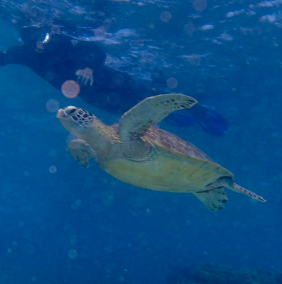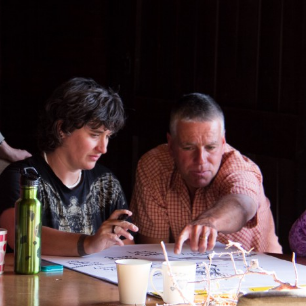
Incorporating diversity: Biomimicry isn’t just for biologists
Biomimicry isn't just for biologists. As our co-founder Dr. Dayna Baumeister likes to say, a "designer" can be anyone.
Read More
Biomimicry isn't just for biologists. As our co-founder Dr. Dayna Baumeister likes to say, a "designer" can be anyone.
Read More
The human-nature connection piece of the workshop helped more fully bridge the connection between the essential elements of biomimicry: emulate, ethos, and (re)connect.
Read More
But how exactly does this ASU accreditation integrate with Biomimicry 3.8 Professional Training programs?
Read MoreWhen it comes to incorporating biomimicry into the built environment–all the spaces that we create to live, eat, sleep, play, and work in–the design potential is hugely exciting.
Read MoreIt’s always fun to look at this map that shows the growing network of Certified Biomimicry Specialists, or as we like to call them BSpecs, who have graduated from our program and gone on to integrate biomimicry into their careers. In fact, there are many more red dots we need to add, as more and more innovators are added to our alumni list. They’re doing things like helping plan the next international biomimicry conference and running companies that apply the principles of biomimicry to increase investment opportunities. You can meet those grads here. It’s exciting to see them integrating biomimicry principles and tools into their primary disciplines, and become leaders in the emerging network of biomimicry researchers and practitioners. Can you see yourself doing the same? The deadline to apply for the Fall B session of the graduate certificate is August 1. You can apply again for the Spring A session on November 1. All the details are here. Our BSpec program has evolved as these...Read More >
Read MoreWe’re heading into the redwood forest outside San Francisco to explore the answer to that question–for a bit at least–during the first of our new training offerings: A three-day training specifically focused on biomimicry design for the built environment. Registration is now open for Inspired by Nature Training: Biomimicry for the Built Environment, which will be held at the HOK office in San Francisco’s Financial District November 2-4. Along with learning in the HOK offices, we’ll head to the California Academy of Sciences and the redwood forest. That’ll give participants a chance to explore nature’s design lessons and experiential play with lessons from local habitats. Then, they can take those lessons back and apply them to their own ecologies and project types. Applying biomimicry design to the built environment can inspire thinking that can help achieve resilient, sustainable design by accessing nature’s proven strategies and design successes defined through 3.8 billion years of evolutionary R&D. It can be applied by architects, planners, designers, design teams,...Read More >
Read MoreSustainable Brands will hold it’s annual conference in San Diego next week, focusing the four days of events on sustainably-led innovation that creates scalable impact and profitability. No doubt that achieving that kind of innovation requires strong leadership. And while design innovations inspired by nature are inherently life-friendly (we always like to say there are no landfills in nature), nature also has much to teach us about effective leadership. That’s the idea Janine Benyus is bringing to Sustainable Brands this year. She’ll take the main stage on Tuesday, June 7, to explain what nature can teach executives about effective, purpose-driven leadership. Janine talked biomimicry and it’s array of innovation inspirations when it comes to combatting things like climate change, contributing to a clean 3D printing revolution, and about the best ways organizations of any kind can integrate biomimicry into their innovation process with Sustainable Brands editor Jen Elks in advance of the conference. In the article, she explained the increased interest...Read More >
Read MoreA typical “meet up” of Master’s of Science in Biomimicry students includes video chats and virtual coursework assignments as they work toward their degrees. But during the Spring Flock at Rancho Robles in Arizona in May, students gathered in-person, where they met their classmates and the faculty and worked together on learning exercises in the Sonoran Desert. It was an optional, low-cost gathering organized by Dr. Dayna Baumeister, The Biomimicry Center co-director and professor of practice at ASU. “There was lots of fun and laughter,” Baumeister said. “We put faces to names and had great dialogue.” Biomimicry 3.8 and ASU partnered in 2015 to begin offering the world’s first accredited master’s degree program for biomimicry. The Biomimicry Center at ASU helps facilitate biomimicry education and research. The program graduated its first group of MS students in the Fall of 2015. Learn more about the programs here The Spring Flock was Baumeister’s idea. It was open to all students enrolled in...Read More >
Read MoreWe’re excited to be helping the International Living Future Institute celebrate a decade of innovation this year during the organization’s Living Future unConference 2016, May 11-13. The celebration will converge on Seattle with the aim of continuing the progress of inspiring green building movement innovators to find solutions to the some of the most pressing global issues. For our part, we’ll be providing a deep dive into exploring how using nature as model, mentor, and measure can help achieve a Living Future. A set of our team and network members will lead a full biomimicry-inspired track at unConference, helping connect participants with the tools and innovation opportunities biomimicry can bring to the built environment and to helping projects achieve Living Product Challenge, Living Building Challenge, and Living Community Challenge imperatives. Here’s a quick glimpse of several of our sessions, beginning Thursday, May 12: Biomimicry + Living Future: Integrating Innovations Inspired by Nature to Achieve a Living Future Biomimicry Thinking for...Read More >
Read MoreWe’re often asked “What do people do with their biomimicry certifications?” In this case the answer is simple: Do good. Certified Biomimicry Specialist Adib Dada was named to Good Magazine’s 2016 Good 100 list for his Bring Beirut River Back To Life work. The list honors “remarkable individuals tackling pressing global issues today.” Dada is the founder and lead architect at theOtherDada. He is a 2012 graduate of the BSpec program. Here’s what Good Magazine had to say about Adib’s work: “The Beirut River is more sludgy sewer than river, complete with rumors of a resident crocodile lurking in the muck. Adib Dada thinks he can clean it up. Using biomimicry techniques developed at theOtherDada, his architecture and design practice, Dada is attempting to rehabilitate the river and reintegrate it into Beirut’s natural ecosystem. He’s also rebuilding the city’s infrastructure around a more symbiotic relationship between nature and the built environment. The first stage, Beirut River 2.0, which addresses infrastructural decay and contamination in the most polluted neighborhoods, is currently under way.” According to its website, the project aims include bringing...Read More >
Read More